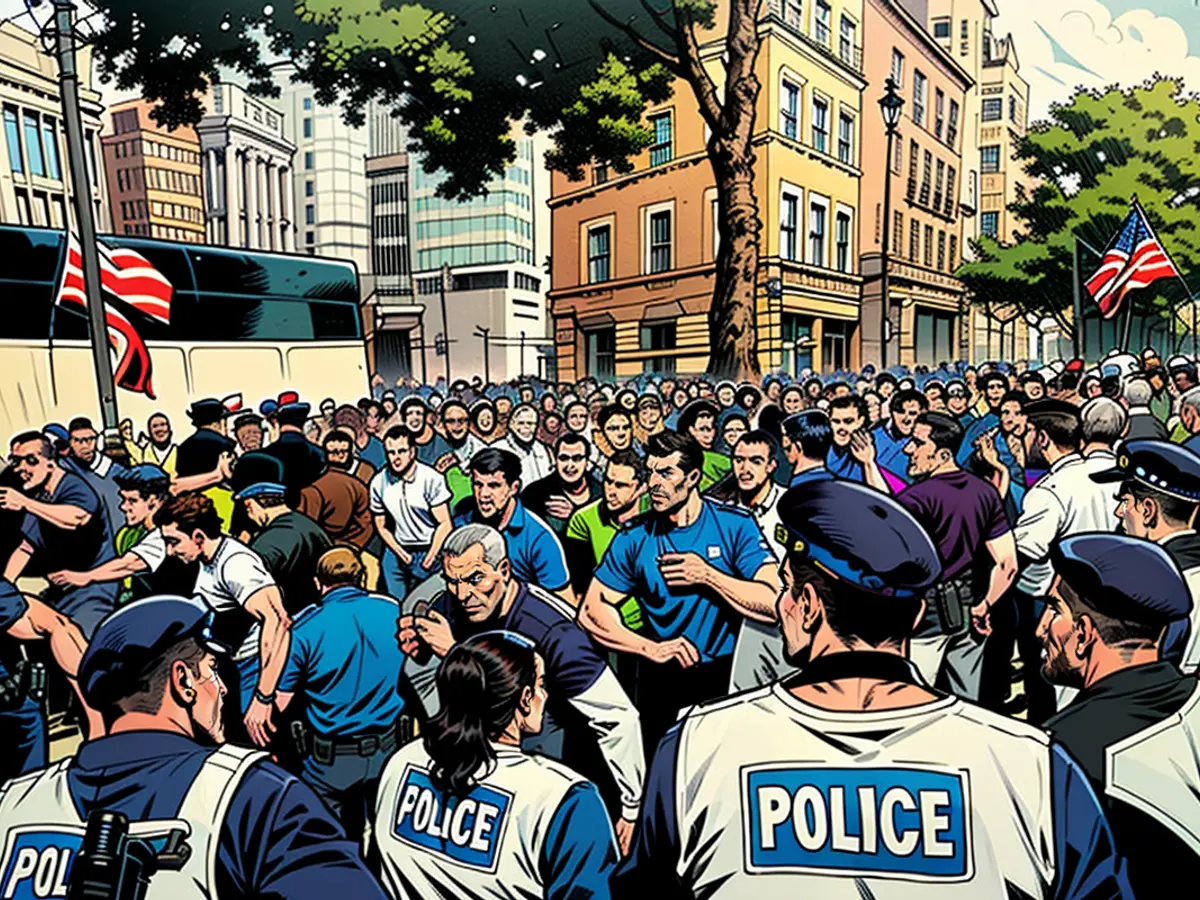"Cities are still being built like they were in the '50s".
On hot summer days, streets, parking lots, and other asphalted surfaces heat up so much that they become a health hazard. Health insurance companies are recording more heart diseases, circulatory problems, headaches, and unfortunately, more heat-related deaths. The German Environmental Aid (DUH) has therefore subjected 190 German cities to a "heat check" and issued a worrying report on ntv's "climate lab": "More than 50 hectares are being sealed off every day," says Federal Managing Director Barbara Metz. What's alarming is not only that green spaces are still disappearing, but also that many cities don't even know how severe the problem is in their own area. "That's unacceptable," says Metz. She demands clear, legally binding guidelines from the federal government for de-sealing and suggests, among other things, moving parking lots from the city center to the outskirts to make more room for trees.
ntv.de: How big is the problem of "heat in cities"?
Barbara Metz: It's a big and well-known issue. In Germany, we've been talking about excessive surface sealing for a long time. In our study, we gave a red card to cities with a sealing ratio of over 50 percent, a yellow card for between 45 and 50 percent, and a green card to those below 45 percent. Even with this generous grading, we had to issue many yellow and red cards. Even in yellow cities, the sealing is already too advanced and must be stopped immediately because living in these cities is harmful to health. Health insurance companies also report an increase in illnesses when cities get too hot. There needs to be more green space.**
What exactly does "sealed" mean? Are these only streets?
Not exclusively. Sealing refers to everything that is built over. That can be streets, but also buildings and parking lots. The correct term is traffic and settlement areas. Anything where water cannot seep in, mostly asphalt or concrete. These surfaces heat up very strongly.**
Because the sun shines on them all day?
Exactly. For us humans, the perceived temperature is crucial, which is why it's also discussed in the weather report: If the air temperature reaches 30 degrees Celsius, an asphalt surface can heat up to over 50 degrees. This heat is radiated into the evening or night, making cities significantly hotter than meadows or forests.**
Those are the counterpart to sealed surfaces? Green spaces like parks or even avenues feel cooler in cities?
When it's really hot, where would you rather stand? In the direct sun, under a sun shade, or under a tree? Most people would probably choose the tree. Therefore, avenues, old tree stands, and parks are crucial for our well-being in cities. We also need roof greenery, facade greenery, and green spaces that provide shade.**
Most sealed surfaces have been created because there was a need. People drive to work by car, people need a residential building to live in. Especially in cities like Berlin, there is a great housing shortage, rents are rising. Now de-sealing surfaces, that doesn't work, does it?
Yes, we live in a built environment. Especially in the 50s and 60s, when Germany was being rebuilt, there was no awareness of this issue. Sometimes, this approach is still taken today. We act as if we have infinite space available, especially when it comes to affordable housing, which can also be created in existing buildings. Studies show this potential. We are not saying that no more building should take place, but we can build less, space-efficiently, and consider where: Should we build into a floodplain where animals live, where there is shrubbery and plenty of green, or on an area that is not as valuable for nature conservation or even wasteland? And then, we must de-seal elsewhere. Schoolyards are a great example: There are 32,000 schools in Germany, and many schoolyards are completely asphalted. These areas can be greened. This would be a win-win situation, also for the children.
"De-sealing" also means streets and parking lots.
If a street is not needed, it should be dismantled. This cannot be answered in general terms. Each city must look at its own situation. If it finds that de-sealing is necessary, it must decide where green can be brought in sensibly. This can be roofs, facades, or schoolyards. Fewer parking spaces are also a good idea to reduce individual traffic and the number of parked cars. Especially in cities like Berlin, there are many parking opportunities directly in front of residential buildings. Why not offer parking spaces outside the cities instead? Supermarket parking lots can also be partially dismantled.
But many car drivers in Berlin already complain that they can't find a parking spot. If you reduce the number of parking spaces, you'll trigger a new wave of protests.
It may disturb some people, but many vehicles are moved little and block parking spaces. These cars can be parked outside and free up space for people who rely on cars. This development is necessary, but of course not without the appropriate offer. You can't just take away the parking space from people. But I'm sure that many people in their daily lives would appreciate fewer cars and a bit more green in front of their own door. We also see this with our heat check: The interest is huge, the topic moves people because they realize how unpleasant the situation in the cities has become.
You mentioned heat, which is harmful to health. Especially when a city heats up for several days. Has this been investigated?
I don't have specific numbers, but we work with health insurance companies. They find that heart diseases, circulatory problems, headaches, and mental illnesses increase significantly on hot days - and of course, the number of heat-related deaths also increases. That's why health insurance companies are also in favor of de-sealing. Green oases in the city where you can sit in the shade reduce health costs, especially for the elderly or families with small children who are not as mobile or can't go to the countryside.
You also looked at the green volume of cities in your study. How do you define a "green oasis"?
Green volume is the cubic meter per square meter: How much green is there per square meter of space. Two cubic meters of green per square meter get a red card, between two and four a yellow card, and everything over four a green card.
Lawn areas score poorly, even though they are green.
Exactly. They are still registered as green spaces, but of course, a tree with a large volume and plenty of leaf greenery is a better shade provider than rolled turf.
84 out of 190 cities have received a green card. Is that a good or a bad result?
Good, because it means that not everything is sealed off. That would be concerning. There are cities with enough green space. However, the ranking shows that we need to redirect because more than 50 hectares are still being sealed off per day. That's too much. Politics has also recognized this: By 2030, the sealing rate is to be reduced to 30 hectares per day. By 2050, the federal government wants to be at net zero. However, this trend is not reflected in the current figures. How is this goal to be achieved without measures? And why so late? How many areas will still be sealed by then? One must keep in mind: It costs money to later re-seal these areas; it costs money to pay for the health consequences. Cities that have received a red or yellow card from us must immediately stop sealing and start re-sealing.
Detmold, Ratingen, Potsdam, and Jena are at the forefront. What do you deduce from this? Is a corresponding policy being pursued there? Are the people demanding green spaces?
It cannot be attributed to parties. There are good and bad examples everywhere. People can also do little in many places. Citizens' initiatives can oppose the construction of something, but not against land sealing. There is no legally binding basis. That is our criticism: Cities must also know what and how much they are allowed to seal. We were even surprised, but there were many responses from cities and communities saying that they finally know where they stand. That's a mess. These data must be collected and made available. Urban planners need an orientation on what they need to pay attention to.
Didn't you say that politics has already recognized the issue?
The Federal Minister of Housing, Building and Urban Development published a heat protection strategy last week, which also states: We need more green in our cities. There is also financial support for municipalities to apply for heat protection measures. That's not wrong, but this incentive alone will not be enough. There needs to be legal certainty so that it is clear during planning: So much green space must be available. If you seal here, you must unseal elsewhere.
That works? Especially the construction industry is already complaining now about the many requirements that have to be observed. That's why almost nothing is being built. If there are more requirements now...
It works. Our building law is completely overloaded and should definitely be revised. That's why we also advocate for simple building. However, I do not accept that bureaucracy is the argument to say that unfortunately, we cannot unseal.
Barbara Metz spoke with Christian Herrmann. The conversation was shortened and smoothed for better understanding. You can listen to the complete conversation in the podcast "Klima-Labor"*.
The German Environmental Aid (DUH), as mentioned by Barbara Metz in the conversation, issued a worrying report on ntv's "climate lab" stating that more than 50 hectares of green spaces are being sealed off every day in Germany. This alarming trend highlights the need for cities to have clear, legally binding guidelines from the federal government to de-seal and make more room for trees, according to Metz.
In her discussion with Christian Herrmann, Barbara Metz emphasized that the German Environmental Aid (DUH) assessed German cities based on their sealing ratio, giving a red card to cities with a ratio of over 50 percent, a yellow card for between 45 and 50 percent, and a green card to those below 45 percent. Despite this grading, many cities in Germany still received yellow and red cards due to excessive surface sealing, which is harmful to health.








